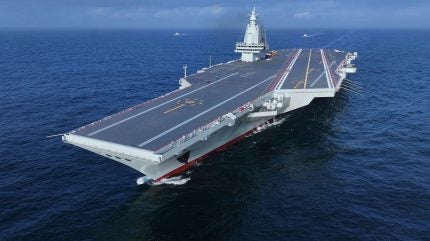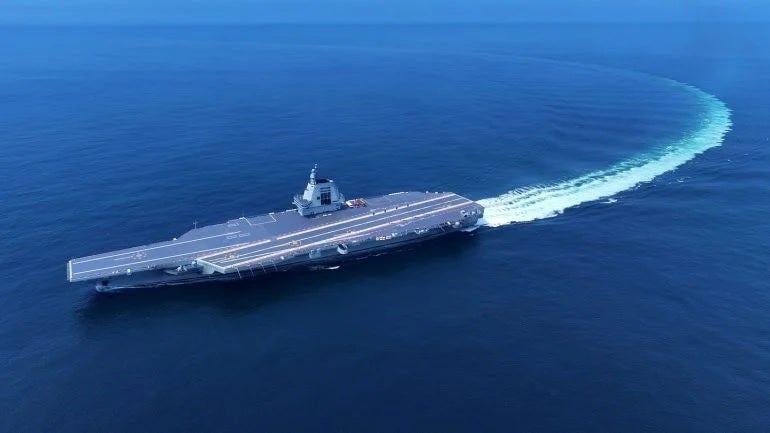
China appears to have stolen another march on US naval development as details emerge of a small aircraft carrier-shaped warship that looks to have been designed from the ground up as a drone flattop, as the People’s Liberation Army Navy (PLAN) seeks to dominate the Western Pacific.
In imagery widely circulated across social media in recent days, the purported drone aircraft carrier appears too short to host and operate larger, crewed fixed- or rotary-wing aircraft, presenting the possibility that it could be developing an entirely new class of warship.
According to GlobalData’s “The Global Naval Vessels and Surface Combatants Market Forecast 2024-2034” report, China will be spending about $46.2bn on procuring various naval vessels over the next ten years. Of this, 8.5% will be directed towards the procurement of amphibious vessels and aircraft carriers, which includes the apparent drone carrier.
This development underscores the PLAN’s intent to augment the application of unmanned aerial vehicles (UAV) to undertake various types of maritime operations, GlobalData analysts stated.
“The growing US assistance to Taiwan and escalating territorial disputes with its neighbors in the South China Sea have long been an irritant for Chinese policymakers. In response, China is advancing its naval capabilities with the introduction of dedicated drone carriers, following the deployment of fixed-wing aircraft [carriers] and helicopter [carriers] in recent years,” said Harsh Deshmukh, aerospace and defence analyst at GlobalData, referencing platforms such as the Fujian and Type 075 respectively.
As the role of UAVs in naval warfare grows, China’s drone carrier, which is approximately one-third the size of the recently launched Type-003/Fujian aircraft carrier, could prove to be an important asset in terms of conducting long-range surveillance missions far away from the Chinese mainland, GlobalData analysts state.
Deshmukh added that the PLAN drone carrier would also improve China’s ability to conduct anti-access/area-denial (A2/AD) operations, making it “more challenging” for rivals to operate freely in disputed areas of the South China Sea.
“As China continues to enhance its blue water capabilities, the launch of this drone carrier before the fourth aircraft carrier (Type-004) shows China’s plan on diversifying its naval forces by inducting more UAVs into its naval fleet,” Deshmukh detailed.
“This rapid militarisation by China could become a cause of concern for many countries in the vicinity and could plunge the region into a new arms race.”
China’s MND says carriers are “defensive”
Following media coverage of the sea trials of the Type 003-class aircraft carrier Fujian recently, China’s Ministry of National Defense (MND) in mid-May stated that the ongoing workup of the vessel “did not target a specific objective, region, or country”, according to an MND spokesperson at the time.
“China remains steadfast in pursuing the path of peaceful development and a defence policy that is defensive in nature,” the spokesperson said.
The sea trials took place at the same time as a joint US-Philippine exercise aimed at asserting free and open use of the South China Sea, which China claims in virtual entirety through its infamous ‘nine-dash line’.

Aircraft carriers are traditionally offensive in nature and used to project power into areas where operating countries do not have land bases and are ideally placed to be used to create A2AD bubbles in the South China Sea to deter other regional or US warships.
Similarly, a country does not develop crewed and uncrewed platforms capable of hosting and operating fixed-wing aircraft without a specific objective in mind.
China has long sought to assert its claims over the South and East China Seas as deter regional rivals such as Japan, Taiwan, and the Philippines, as well prevent continued US access to what Beijing considers its territorial waters.
A recently published guide to China’s surface naval development of the IUS Office for Naval Intelligence revealed the scope of Beijing’s maritime spending, detailing a PLAN surface force that already far exceeds the US Navy in numerical terms.








